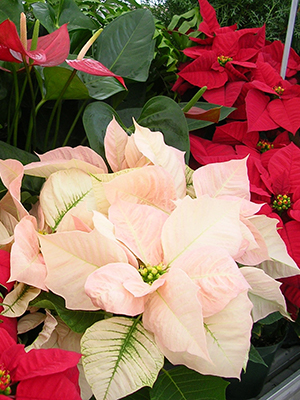Five Facts About the Poinsettia

Poinsettias are the most popular plants for the holiday season. Photo courtesty of Marc Frank, UF/IFAS. All rights reserved.
By Marc Frank, Extension Botanist
1. It is named for the person who introduced it to the United States
The poinsettia was brought to the United States from Mexico around 1828 by Joel Roberts Poinsett. An avid gardener and amateur botanist, Poinsett was serving as a congressman from South Carolina when he was appointed as the first US Minister to Mexico (a position that he held from 1825 to 1829). While in Mexico, Poinsett observed this species flowering and sent plants back to his greenhouse in Charleston. Until that time, this species was unknown outside of its native range of Mexico and Guatemala, where it was referred to as flor de nochebuena (Christmas Eve flower). Once introduced to the U.S., it quickly gained the common name poinsettia, but is also known by many other common names including Christmas flower, Christmas star, lobster plant, painted leaf, and Mexican flame leaf.
2. The showy part of the plant is a leaf, not a flower
The whorl of brightly colored structures we think of as flower petals are actually bracts — modified leaves, which function to attract pollinators to the relatively small and inconspicuous actual flowers at the center. Compare a bract with one of the leaves and you will notice they are quite similar in structure, but are just differently colored. In wild poinsettias, the bracts are typically bright red, but horticulturists have now bred varieties with bracts in varying shades of white, pink, purple, orange, and yellow.
3. Poinsettias form flowers in response to day length and temperature
Poinsettias do not produce flowers year-round. Instead, this species initiates flower buds in winter when the nights are longer than the days. While known as "short day plants," it is actually the exposure to darkness that is critical to the formation of colorful bracts and flower buds. Dark periods of 11 hours, 45 minutes will initiate flowers in most poinsettia varieties, but initiation is most rapid at 14–14.5 hours of darkness. Temperatures above 79 degrees can delay flower initiation, as can exposure to outdoor lights. In order to have poinsettias ready to sell by Thanksgiving, commercial poinsettia growers need to create ideal conditions in their greenhouses in late September or early October. They do this by pulling light-excluding fabric over their nursery benches each afternoon to achieve the required period of darkness and maintain their greenhouses at 62-68 degrees.
4. Poinsettias are not as poisonous as you may have heard
This species has a reputation for being extremely poisonous. While there is little doubt that the milky latex of poinsettias can cause irritation to the skin, eyes, mucus membranes, or when consumed, to the digestive system, poinsettia is apparently one of the less toxic species of Euphorbia.
According to Toxic Plants of North America¹, "Most accounts of poinsettia poisoning are unconfirmed and not consistent with experimental evidence and carefully evaluated clinical experiences. Analysis of 22,793 cases of reported human exposures to poinsettia revealed that 93.3% were in children, that there were no fatalities, and that in 92.4% there were no signs of adverse effects."

Poinsettias have been bred for bracts of many different colors. Photo courtesy of Marc Frank, UF/IFAS. All right reserved.
5. Poinsettias are a high-value crop
According the USDA, poinsettias are the second largest-selling flowering potted crop in the country (orchids are the biggest seller). In 2018, U.S. potted poinsettia sales totaled $149 million.
Marc S. Frank
Extension Botanist
UF/IFAS Plant Identification and Information Service
University of Florida Herbarium
Also on Gardening Solutions
1. Burrows, George E. and Ronald J. Tyrl. 2013. Toxic Plants of North America, 2nd ed. Wiley-Blackwell, Hoboken, NJ.

